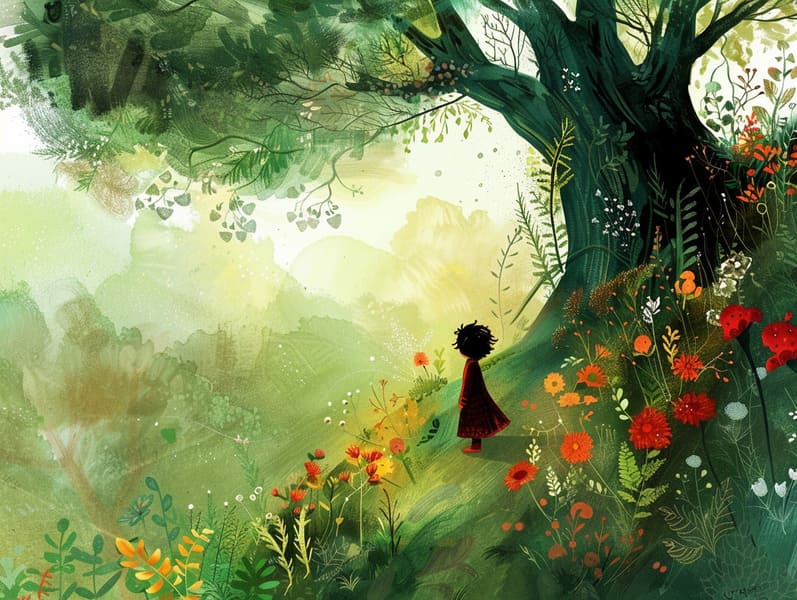
Fairy tales for kids have ancient roots. These narratives have been whispered from one generation to the next ages before they were ever documented. They emerged from a variety of traditions, including American traditions. They were initially disseminated among elders, often carrying themes and messages related to the societal norms and beliefs of the time.
The famous Grimm duo, the two Grimm brothers, were among the first to compile many of these beloved tales. Their compilation, "Grimm's Children's Stories," included tales like "The Story of Cinderella," "The Story of Hansel and Gretel," and "Snow White," which have since become classics in the world of traditional fairy tales. Similarly, Andersen's fanciful fairy tales, such as "The Little Mermaid," and "The Duckling that Could," have floated into hearts worldwide, securing their place in the pantheon of famous fairy tales.
Despite their historical roots, traditional fairy tales remain as important as ever, especially as children's bedtime stories. These magical stories are now available in multiple formats, including richly illustrated books, enchanting animations, and internet fairy tales.
Their continued relevance can be linked to several magical reasons:
Valuable Lessons: Old fairy tales often share important moral lessons. Tales like "The Tale of the Boy Who Cried Wolf" teach the virtue of honesty, while "The Story of the Tortoise and the Hare" point out the benefits of determination and humbleness. These stories offer young readers clear distinctions between truth and falsehood, guiding their moral compass in a subtle yet meaningful way.
Warmth and Understanding: Classic fairy tales frequently feature protagonists facing difficulties and adversities, provoking young readers to comprehend with their struggles and back their triumphs. For instance, "Beauty and the Beast" reveals the benefit of looking past the exterior to know the true essence of a soul, strengthening kindness and perception.
Cultural Perception: Many old fairy tales are rooted in the cultural contexts from which they sprang. Delving into these narratives can provide captivating looks into different backgrounds, building a sense of global respect and acknowledgment.
Creativity and Fantasy: The enchanted elements in timeless fairy tales—spells and potions—provoke children’s fantasies. These narratives bring readers to imaginary realms, kindling innovative thinking and a sense of amazement that lasts a lifetime.
Timeless fairy tales are not only charming but also educational. They function as bewitching tools in developing various cognitive and emotional skills in young readers. When classic fairy tales are spoken out loud, they develop language skills by offering new lexicon and elaborate sentence structures. This practice also strengthens hearing perception and attentiveness, as young readers follow the story, looking forward to see what happens next.
Furthermore, deliberating the themes and characters of classic fairy tales can enhance evaluative skills and evaluative skills. Young readers are guided to recognize patterns, foresee events, and get cause and effect. These debates also support children reveal their thoughts and feelings, strengthening their emotional intelligence.
In today’s cyber age, the proliferation of digital storybooks has made these narratives more accessible than ever. Internet resources and mobile apps feature ample collections of traditional fairy tales that can be perused or heard anytime, anywhere. Fairy tales recited are particularly popular, offering an enjoyable way for the young to savor these enchanting tales. Read-aloud stories and read-to-me stories guide characters and settings to life, often complemented by charming harmonies and instrumentals that boost the story journey.
The everlasting appeal of traditional fairy tales lies in their ability to adapt to present days while keeping hold of their fundamental ideas. Contemporary revisions of these stories often include more varied figures and modern settings, making them understandable to today’s audience. However, the central morals of guts, goodness, and honesty remain unchanged, continuing to strike a chord with young readers of all ages.
Traditional fairy tales also offer a sense of protection and understanding. They render accessible a orderly narrative with a unmistakable beginning, middle, and end, often concluding with the termination of conflicts and the triumph of goodness over badness. This dependability can be reassuring for young ones, yielding a sense of firmness in an fluid world.
Classic fairy tales continue to entrance and train new generations, maintaining their allure and significance in modern society. As children's bedtime stories, they impart check it out upon a perfect blend of delight and instruction, advancing moral values, empathy, and creativity. The accessibility of free fairy tales online and the likability of fairy tales read out loud confirm that these timeless tales remain accessible to new generations.
By conserving and circulating these narratives, we continue to exalt the rich tapestry of legends and cultural heritage. Whether you are reading a gorgeously illustrated book, discovering a virtual collection, or listening on an audio story, the magic of children's fairy tales is always within reach. These narratives emphasize of the ageless magic of tales and its ability to tie us across generations and cultures.
Be it you are reading a colorful picture book, seeing a internet library, or hearing an sound book, the grandeur of traditional fairy tales is always within reach.
These stories point out of the everlasting force of narratives and its ability to draw us together across epochs and places, casting a charm that charms and informs alike.